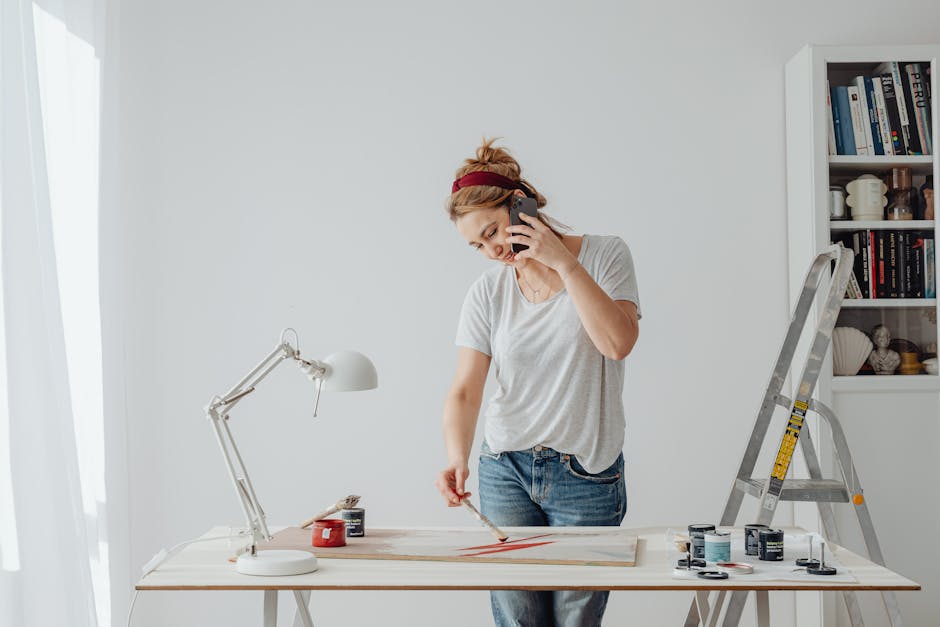Table of Contents
The year is 2025. You know, sometimes I just sit here, trying to figure out how people get so much stuff done. Like, for real. Everyone’s always talking about planners and apps and ticking boxes, and I get it, that stuff helps some folks. But then you look at other people, the ones who always seem to be cooking up wild ideas, and their desks are often a mess. Or maybe their schedule looks, well, a bit chaotic from the outside. And you wonder, how do they manage to actually, you know, do things? It got me thinking: what if the way we think about time, especially when we’re trying to be creative, isn’t about fitting everything into neat little boxes? What if it’s totally different?
See, there’s this weird thing that happens when you’re really into something, when your brain is buzzing with new thoughts. Time kind of stretches, or it shrinks, or it just… disappears. You could be working on a project that feels like five minutes, but hours have actually flown by. Or you’re stuck, trying to force an idea, and every minute feels like an hour. That’s creativity, right? It doesn’t exactly punch a clock. So how does that even fit with time management, which is all about schedules and deadlines and, like, being on time for things? It’s a puzzle, for sure.
For ages, it seemed like these two things were at war. Creativity was seen as this free-spirited artist type, maybe a bit flaky, living by inspiration. Time management was the stern accountant, all about numbers and rules. But what if they’re not enemies? What if they’re actually doing a weird little dance together? Because, I mean, even the most creative person has to pay bills, right? Or get their crazy ideas out into the world. That means some kind of management, even if it doesn’t look like what the gurus preach.
Creativity Isn’t Always a Straight Line
Think about it. When you’re trying to come up with something new, whether it’s a story, a new way to organize your sock drawer (don’t laugh, it’s a creative challenge!), or a business pitch, you don’t just go A to B to C. Sometimes you go A to Z, then back to F, then maybe you loop around to B again. You hit dead ends. You doodle on napkins. You stare blankly at a wall for twenty minutes, and then, boom, an idea pops into your head. That twenty minutes wasn’t “wasted.” It was part of the process.
This messy, non-linear approach to creative work totally messes with standard time management. If your calendar says “9 AM – 10 AM: Brainstorm new marketing slogans,” and you spend half that time staring at a houseplant, a lot of people would say you’re slacking. But what if that houseplant-staring was exactly what you needed to do to get the right idea? It’s not about being inefficient; it’s about being effective in a way that’s not easily measured by a stopwatch.
I remember this one time, I was trying to write a paper, and I just couldn’t get the opening paragraph right. I kept trying to force it, sitting at my desk, feeling frustrated. Eventually, I just gave up and went for a walk. And, like, halfway down the street, it just hit me. The whole intro, clear as day. If I had stayed chained to my desk, trying to “manage my time” by staying put, who knows how long it would have taken? Sometimes, the most productive thing you can do for creative work is to actually not work in the traditional sense. It’s counter-intuitive, but it’s often how minds work when they’re making connections.
Making Space for the “Aha!” Moments
So, if creativity needs room to wander, what does that mean for time? It means we need to build in “white space” or “buffer time.” Not just to catch up on emails, but literally to do nothing, or to do something completely unrelated. This isn’t laziness; it’s a strategic move. Those blank spots in your schedule, or those moments when you’re supposed to be doing one thing but your mind goes off on a tangent, those are often where the sparks fly.
It’s like, if you pack your suitcase too full, you can’t fit anything else in, right? Your brain is kind of like that. If every single minute of your day is scheduled solid, where’s the room for a new idea to sneak in? Where’s the room for you to connect two seemingly unrelated thoughts and create something cool? When you’re constantly rushing from one task to the next, there’s no breathing room for that creative part of your brain to do its thing. And that’s a problem because new ideas, they don’t exactly just pop up on command, not usually anyway.
Finding Your Creative Flow (and What It Does to Time)
Okay, so let’s talk about “flow.” It’s this state where you’re super absorbed in what you’re doing, and you kind of lose track of yourself, your surroundings, and yes, time. Athletes get into it. Musicians get into it. Writers, coders, even people building LEGO castles can get into it. When you’re in flow, you’re not thinking about the clock. You’re just doing. And you’re doing it really well.
This is where creativity and time management meet in a weird, almost magical way. When you’re in flow, you’re incredibly productive without even trying to be. You’re not “managing” time; you’re bending it. A three-hour session might feel like thirty minutes, but you’ve done work that would normally take you a full day. This is the holy grail, isn’t it? Getting a ton done, without feeling stressed, because you’re actually enjoying the process.
The trick, I guess, is figuring out how to get into that flow state more often. And it’s different for everyone. For some, it’s about having a quiet space. For others, it’s a specific kind of music. What’s interesting is that it often requires less external structure, not more. It’s about minimizing distractions and giving your brain the freedom to dive deep. And that means maybe not checking your phone every five minutes or having a million alerts pop up on your screen.
Rethinking “Productivity” Beyond the Clock
We’ve all been taught that productivity equals doing more in less time. And that’s fine for some things, like processing emails. But for creative tasks, maybe it’s about doing the right thing, even if it takes a bit longer, or if the path to getting there is circuitous. It’s about quality over sheer quantity. If a brilliant idea takes a few extra hours, but it saves you weeks of rework later on, or it changes everything for the better, then those hours were incredibly well spent.
My friend, Sarah, she’s a graphic designer, right? And she used to be super strict with her time, every minute accounted for. But she kept hitting creative blocks. Everything felt forced. Now, she actually schedules “playtime” into her day. She’ll spend an hour just messing around with new software, or sketching random things, or even just looking at art online. And she says it’s made her actual client work so much better and faster. Because when she sits down to design, her brain is already warmed up, full of fresh ideas, instead of feeling like a dried-up sponge. So, that “unproductive” play is actually part of her very creative and effective time management strategy. Who’d have thought?
Using Creativity TO Manage Time
Now, here’s a flip side: creativity isn’t just affected by time management; it can also help with time management. When you think creatively, you’re looking for new solutions, new ways to do things. So, if your current time management system isn’t working, why keep forcing it? Be creative about it!
Maybe the traditional to-do list doesn’t work for you. So, invent a new one. Maybe it’s a visual one, or one where you only write down three things a day, no matter what. Maybe you create a weird game out of getting things done. I know a guy who sets a timer for 25 minutes, then he just dances for 5 minutes. And he swears it helps him focus better in the next sprint. That’s a creative approach to managing his work blocks, isn’t it?
Think about how you break down big projects. Instead of just listing tasks, maybe you visualize the whole thing like a story. Or you brainstorm all the ways it could go wrong, just to find clever ways around those problems before they even happen. That’s using your creative brain to make the whole process smoother and, in the end, more time-efficient. It’s not about following a template; it’s about designing a system that works for you.
The Messy Schedule and the Brilliant Idea
Sometimes the most innovative solutions come from a place of apparent disorder. Someone’s desk might look like a bomb went off, but they know exactly where everything is. Their mind might be jumping from one idea to the next, but they’re making connections that someone with a perfectly linear, organized mind might miss. It’s not necessarily about being sloppy; it’s about having a different kind of order, one that supports their creative process.
I’m not saying everyone should ditch their calendars and live in chaos. That’s not practical for most jobs. But what I am saying is that we need to stop thinking of time management as this rigid, one-size-fits-all thing, especially when creativity is involved. It needs to be flexible. It needs to be adaptable. And it needs to let you wander sometimes, let you dream, let you fail, and let you find those unexpected pathways to a brilliant idea. Because that’s often where the magic happens. And in 2025, with everything moving so fast, we need more of that magic, don’t we?
understanding Time as a Creative Material
You can look at time not just as something to be managed, like a budget, but almost like a material you’re working with, similar to paint or clay. When you’re creating something, you don’t just slap the paint on or mash the clay randomly. You consider its properties, how it behaves, how it interacts with other things. Time is kind of like that. You don’t just fill it up; you think about how you’re using it, the quality of the time, not just the quantity.
For instance, some tasks, especially creative ones, need uninterrupted blocks of time. You can’t write a great piece of code or a compelling story in 15-minute chunks scattered throughout the day. It needs a deeper dive. Other tasks, like brainstorming or thinking about a new problem, might benefit from short, intense bursts followed by a break. Recognizing these different needs, and then arranging your time like you would arrange colors on a palette (or ingredients in a recipe, whatever analogy works for you), that’s a creative act in itself. It’s about designing your day, not just filling it up. And that’s a pretty powerful idea, I think.
FAQs: How Does Creativity influence Time Management?
Q1: So, does being creative mean I’m just bad at time management?
A: Not at all! Actually, it means you might approach time management differently. Creative people often need more flexibility, less rigid schedules, and specific kinds of “unproductive” time (like daydreaming) that actually fuel their work. It’s about finding a system that supports your unique way of thinking, not fighting against it.
Q2: Can I actually use creativity to get better at managing my time?
A: Absolutely! Thinking creatively about your schedule means you’re not stuck with traditional methods. You can come up with new ways to prioritize, design a visual task list, or even invent little games to make mundane tasks more engaging. Being innovative in your time approach can lead to much better results.
Q3: How do I balance open-ended creative time with deadlines?
A: It’s a tricky one, but it’s totally possible. Try scheduling “deep work” blocks for your creative tasks where you minimize distractions. Also, build in buffer time or “white space” around those blocks. This gives you room for ideas to emerge or for tasks to spill over a bit without derailing your whole day. And don’t forget to factor in time for those random “aha!” moments.
Q4: Will I be less productive if I prioritize creative flexibility over strict schedules?
A: It might feel that way at first, but often, the opposite happens. When you allow your brain the freedom to be creative, you can come up with more original and effective solutions, which can actually save you time in the long run. Quality over quantity, right? Plus, working in a way that feels more natural can reduce burnout.












